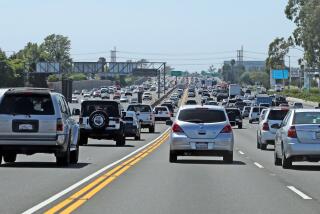Plan Would Put Radar Guns in Residents’ Hands
THOUSAND OAKS — Next time some motorist is high-tailing it through one of this city’s quiet streets, he may have a surprise in store: His neighbor may be toting a radar gun and lying in wait.
Traffic officials from the Ventura County Sheriff’s Department and Thousand Oaks have devised a plan--the first of its kind in the county--to allow residents to borrow radar guns and monitor speeding in their neighborhoods.
The civilian traffic watchers would hand over the scofflaws’ license plate numbers and rate of speed to police, who would send warning letters to the cars’ owners. If the same vehicle was caught speeding three times, deputies would stop by the owner’s house for a little chat.
Dubbed the Neighborhood Speed Awareness Program, the concept has been reviewed and approved by the city’s Traffic and Transportation Advisory Commission. The City Council is expected to approve the plan on a trial basis tonight, using a pair of extra radar guns owned by Thousand Oaks and the Sheriff’s Department.
“It’s really not being done to intimidate,” said Cathy Schutz, chairwoman of the city’s traffic commission. “I think a lot of times the speeders are people in the neighborhood, but the people don’t realize how fast they’re driving sometimes. We’re just hoping to get them to slow down.”
Sheriff’s Sgt. Ken Bailey said roughly 90% of the complaints that police receive in Thousand Oaks deal with traffic and speeding--which speaks to the city’s standing as one of the safest communities in the U.S., but also cuts into the time officers could be spending on more serious problems.
After reading about a similar program conducted by the Los Angeles Police Department in West Los Angeles, Bailey and city traffic engineers decided to try loaning residents radar guns in Thousand Oaks. The idea, Bailey said, is to use the energy of those who are fed up with speeders, to work toward a solution.
“The citizens would not get involved in enforcement in any way,” Bailey said. “They would simply be another pair of eyes for us. It seems like every neighborhood in town has this problem.”
Neighborhood groups often complain to Thousand Oaks officials about motorists whizzing through residential streets, and the groups frequently ask for special measures, such as speed humps, to counter the problem, said city Traffic Engineer John Helliwell.
In addition to regular traffic patrols, Thousand Oaks places mobile radar units alongside roads that are known to attract speeders. The machines show motorists how fast they’re driving, in hopes that they will voluntarily reduce their speed.
Not all neighborhoods meet the requirements for speed humps, and often the alleged speeders are not driving as fast as critics believe, according to Helliwell.
With the radar gun plan, residents whose streets do not have sufficient traffic to qualify for speed humps would be able to combat speeding another way.
Those who suspect certain people of speeding would be able to better determine when someone is breaking the law, and those who may not be aware of their pedal-to-the-metal tendencies would receive fair warning, according to Helliwell.
“There are not too many engineering solutions to speeding, and the police can’t be on every corner,” Helliwell said. “We don’t know what will happen with this. It’s just a pilot program, but it seems better than putting speed humps all over town.”
He said he plans to provide the City Council with a status report after the program is tested in two or three neighborhoods.
Marilyn Bell is one of a group of homeowners who complained to Thousand Oaks’ traffic commission about speeding on her street--Greenmeadow Avenue--and pleaded for speed humps. The residents were told their street did not qualify.
Though she commends Thousand Oaks officials for seeking new solutions to speeding, Bell said she worries that neighborhood activists would be placing themselves in danger by waving radar guns at drivers who, to put it mildly, are not always receptive to such concerns.
“They use this street as a shortcut, and they’re hauling by the time they get up here,” Bell said. “So the radar, as much as it sounds like a good idea, it makes the residents the vigilantes. If I tell people to slow down, I usually get flipped off or screamed at. One person even comes by and revs his engine. It’s nasty out there.
“I would be genuinely concerned for the safety of the residents who carried those guns.”
Vern Doty, who also lives on Greenmeadow Avenue, sees the plan differently.
“Anything that we can do, I’m for,” Doty said. “I’d take my turn doing that--I’m not going to do it all by myself, but if other people were going to do it, I’d do it.”
Council members on both sides of the city’s political divide said the radar gun plan sounds like a good idea but may need a bit of work.
Councilman Andy Fox said that as long as police send the warning letters and make all contact with drivers, radar gun volunteers should not be in danger. He praised the idea as a thoughtful way of dealing with a perennial neighborhood problem.
“Any time we can get residents more involved in tackling the problems in their communities, I’m all for it,” Fox said. “But the police have to be the enforcers. What we don’t want is a neighbor-versus-neighbor situation.”
“I’m certainly in support of this in concept,” Councilwoman Elois Zeanah said. “We seem to be getting more and more complaints of speeding in this city, and the police can’t get involved in everything. This is a way for residents to help.”
More to Read
Sign up for Essential California
The most important California stories and recommendations in your inbox every morning.
You may occasionally receive promotional content from the Los Angeles Times.










